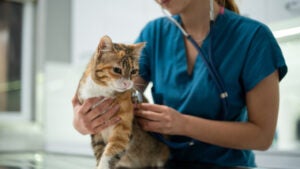Should you get pet insurance for your cat or kitten?

Owning a cat can be a joy, but caring for one comes with financial responsibilities many pet parents’ underestimate. From unexpected accidents to managing chronic illnesses, the cost of veterinary care can quickly add up. Cat insurance provides a safety net to help cover these expenses, ensuring your feline friend receives the care it deserves without breaking the bank.
Before making a decision about pet insurance for your cat, get to know what it covers and the most common reasons to invest in this financial safeguard.
How does cat pet insurance work?
Cat insurance works similarly to health insurance for humans. It covers a portion of your cat’s eligible medical expenses after you pay the vet bill.
Some providers, like Trupanion, offer direct pay at participating veterinary clinics. This means you only pay the uncovered portion of the bill at checkout, with the rest paid by the insurer. Other companies operate on a reimbursement model, requiring you to submit claims for eligible expenses.
What does pet insurance for cats cover?
The coverage included in pet insurance for cats depends on the plan. Common covered expenses include:
- Diagnostics: Blood tests, X-rays and other procedures to diagnose illnesses or injuries.
- Hospitalization and surgery: Costs related to emergency care or necessary operations.
- Medications: Prescription drugs for chronic or acute conditions.
- Specialized care: Treatments like physiotherapy, hydrotherapy or acupuncture.
Some policies also include extras like prescription diets or behavioral therapy, which can be especially helpful for managing long-term conditions.
The reimbursement process
For reimbursement-based plans, the process is straightforward:
- Pay your vet bill upfront.
- Submit a claim to your insurance provider with a detailed invoice. Most pet insurance companies have user-friendly online member portals or mobile phone apps to simplify this process.
- Receive reimbursement based on your policy’s terms (e.g., 70–90 percent of eligible costs after your deductible). Your refund is typically paid into a bank account of your choice or sent to you as a check in the mail.
What does cat insurance cost?
The cost of pet insurance for cats depends on factors like your cat’s age, breed and location, as well as the type of plan selected.
According to the National Association of Pet Health Insurance (NAPHIA), the average premiums for cat insurance in 2023 were:
- $9.68 per month for accident-only policies.
- $31.94 per month for accident and illness policies.
Why should you consider pet insurance for your cat?
You might consider insuring your cat for many different reasons. Here are a few of the most common motivations among pet owners.
1. Costs of pet care
Veterinary care can be surprisingly expensive, especially for illnesses or injuries that require extensive treatment. Consider some common health issues in cats and their estimated costs:
- Feline urinary tract infections (UTIs): $200–$600 per occurrence for diagnostics and treatment.
- Diabetes: $95–$210 per month for insulin and monitoring.
- Kidney disease: $50–$500 monthly for medication and special diets.
- Feline leukemia virus (FeLV): $200–$1,000 annually for treatment and management.
Even routine care like vaccinations, spaying/neutering and dental cleaning can add up. Pet insurance can alleviate the financial burden, enabling you to focus on your cat’s health rather than your budget.
2. Peace of mind
By nature, accidents and illnesses happen when you least expect them to. Knowing that your insurance provider will help cover unexpected vet bills can bring you peace of mind. You won’t have to weigh your cat’s health against financial constraints. With insurance, you can confidently address your cat’s medical needs, whether emergency surgery or long-term treatment for a chronic condition.
3. Pet insurance can promote more regular vet care
Sometimes, pet owners delay or avoid taking their cats to the vet due to concerns about high costs. This can result in worsening health conditions that become more difficult — and expensive — to treat. A good insurance policy can help you stay proactive with your cat’s care, from annual wellness visits to addressing minor symptoms early on.
4. Coverage for emergencies
Cats are curious creatures, and that curiosity can sometimes lead to mishaps like ingesting foreign objects or sustaining injuries. Emergency vet visits can range from $500 to $3,000, depending on the situation. With insurance, you’re better prepared for these unexpected expenses.
5. Protection against complications from chronic illnesses
As cats age, they become more susceptible to chronic conditions like arthritis, diabetes, hyperthyroidism or kidney disease. Treatments for these conditions often require ongoing care, medications and specialized diets. Insurance helps manage the cost of long-term care, ensuring your cat stays comfortable and healthy.
How do you compare cat insurance plans?
Comparing pet insurance plans for cats involves evaluating both cost and coverage. Familiarize yourself with these terms to make informed decisions:
- Monthly premium: The amount you pay each month for your policy.
- Deductibles: The amount you must pay out-of-pocket before insurance coverage kicks in.
- Reimbursement rate: The percentage of eligible expenses covered (typically 70–90 percent).
- Annual limit: The maximum amount your insurer will pay in a policy year.
- Pre-existing conditions: Most pet insurance companies do not cover costs associated with health conditions your pet has before your coverage begins. Some providers will cover certain curable conditions once your pet is symptom- and treatment-free for a pre-determined period.
- Benefit schedule: A list outlining coverage amounts for specific treatments or conditions.
- Maximum per condition payout: The cap on how much an insurer will pay for a particular condition.
- Waiting periods: The time between policy activation and when coverage begins.
- Claim expiration: The deadline for submitting claims after a vet visit.
How do you choose the right pet insurance for your cat?
Choosing the right pet insurance for your cat requires careful consideration of your cat’s needs, your budget and the policy details. Here’s a step-by-step guide to help you make an informed decision:
1. Assess your cat’s health needs
Every cat is unique, and health history, age and lifestyle play a role in determining the type of insurance they need. Consider the following:
- Age: Kittens are more prone to accidents, while older cats are at risk of chronic illnesses.
- Breed: Some breeds are predisposed to specific health conditions (e.g., Persians and polycystic kidney disease).
- Lifestyle: Outdoor cats may need accident-focused coverage, while indoor cats may benefit more from illness protection.
2. Understand coverage options
Pet insurance companies generally offer three types of plans for cats:
- Accident-only plans cover injuries resulting from accidents, such as broken bones or swallowed objects. These policies are typically the most affordable.
- Accident and illness plans provide coverage for injuries and illnesses like diabetes or kidney disease.
- Wellness plans focus on preventive care, including vaccinations, dental cleanings and annual exams. Some companies offer these as add-ons to accident and illness plans.
Choose a plan that aligns with your cat’s needs and your financial priorities.
3. Compare costs
Premiums vary based on your cat’s breed, age and location. While cost is important, don’t focus solely on the monthly premium. Compare plans by factoring in:
- Deductibles: Higher deductibles usually lower your premiums while lower deductibles increase your monthly insurance premiums.
- Reimbursement rates: A higher reimbursement rate will translate to a higher premium.
- Annual limits: Higher annual limits usually result in higher premiums.
A plan with a low premium might have higher deductibles or lower reimbursement rates, so balance affordability with your need for comprehensive coverage.
4. Research waiting periods
Insurance providers have different waiting periods for covering costs related to accidents and illnesses. Common waiting periods include:
- Accidents: Typically one to three days.
- Illnesses: Usually 14 days.
- Specific conditions: Some plans may have extended waiting periods (up to six months) for conditions like hip dysplasia or cruciate ligament injuries.
If your cat needs immediate coverage, choose a plan with shorter waiting periods.
5. Check for exclusions
Read the fine print to understand what’s excluded from coverage. Common exclusions include:
- Breeding-related costs
- Certain chronic conditions, depending on the insurer
- Cosmetic procedures like declawing
- Pre-existing conditions (illnesses or injuries diagnosed before the policy started)
Understanding exclusions ensures you’re not caught off guard when filing a claim.
6. Evaluate additional benefits
Some policies offer perks like:
- Behavioral therapy coverage
- Coverage for alternative therapies like acupuncture
- Direct vet pay
- Prescription diet reimbursements
If these features align with your cat’s needs, they may justify slightly higher premiums.
7. Read reviews and compare providers
Read through Bankrate’s list of the best pet insurance companies to identify reputable providers whose offerings align with your needs. Consider the following:
- Claim processing times
- Customer service quality
- Ease of submitting claims (e.g., online or via an app)
- Flexibility to customize coverage
9. Consider the big picture
Investing in pet insurance can result in significant savings in the long run, especially if your cat faces health challenges. Even indoor cats, often perceived as less accident-prone, can develop chronic conditions requiring costly treatments. The following approaches can help you make the most of your coverage options:
- Start young: Insure your cat while it’s healthy to avoid exclusions for pre-existing conditions.
- Seek transparency: Choose insurers that clearly outline coverage, costs and exclusions.
- Plan for the unexpected: Opt for accident and illness coverage, if possible, as these scenarios often result in the highest vet bills.
- Reassess regularly: As your cat ages or its health changes, its insurance needs may evolve. Review your policy annually to ensure it still meets your cat’s requirements and fits your financial situation.
The bottom line
Cat insurance offers a financial safety net that allows you to provide the best care for your feline companion. By understanding how insurance works and assessing your cat’s unique needs, you can select a policy that provides peace of mind and protection against unexpected veterinary costs.
Frequently asked questions
Why we ask for feedback Your feedback helps us improve our content and services. It takes less than a minute to complete.
Your responses are anonymous and will only be used for improving our website.
You may also like

Does pet insurance cover pre-existing conditions?


Should you get pet insurance or a pet savings account?

Do you need pet insurance for a kitten?


